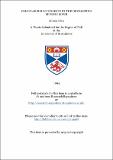Files in this item
Cellular relationships in the developing murine liver
Item metadata
| dc.contributor.advisor | Thomas, D. Brynmor | |
| dc.contributor.author | Blair, Allison | |
| dc.coverage.spatial | 278 p. | en_US |
| dc.date.accessioned | 2018-07-05T09:59:23Z | |
| dc.date.available | 2018-07-05T09:59:23Z | |
| dc.date.issued | 1994 | |
| dc.identifier.uri | https://hdl.handle.net/10023/14968 | |
| dc.description.abstract | Haematopoietic activity in the murine fetal liver was observed to increase from the 12th day of gestation to reach a peak on the 15th day of gestation. Hepatic haematopoiesis is predominantly erythroid. As maturation proceeds the numbers of myelopoietic cells increase. Haematopoietic activity declines after the 15th day of gestation, though haematopoietic cells were still obvious in the liver of the 10 day neonate. Cellular interactions were studied in vivo with the electron microscope and in vitro using long term cultures. Haematopoietic cell clusters were abundant in fetal liver both in vivo and in vitro. Macrophages and hepatocytes act as the central supporting cells of these clusters. There was evidence of communication between the central supporting cells and the blood cells precursors, which may be essential for the maintenance of haematopoiesis both in vivo and in vitro. A high proportion of early HPP-CFC derived from fetal liver are synthesising DNA, while HPP-CFC derived from adult bone marrow are relatively quiescent. The kinetic properties of the HPP-CFC population are very similar to those of the CFU-S population both in fetal liver and in adult bone marrow. A high proportion of GM-CFC which are a more mature class of progenitor cells were cycling in both fetal liver and adult bone marrow. Fetal liver extract was shown to have an overall inhibitory effect on haematopoiesis in normal bone marrow and irradiated bone marrow and on colony formation by leukemic cells. Detrimental effects on normal bone marrow cells were observed only with high concentrations of fetal liver extract. Fetal liver blood cell precursors were found to adhere preferentially to bone marrow stromal layers, which could not be attributed to the kinetic properties of these cells. This preferential adhesion may promote the in vivo accumulation of haematopoietic stem cells derived from fetal liver in the medullary cavities. | en_US |
| dc.language.iso | en | en_US |
| dc.publisher | University of St Andrews | |
| dc.subject.lcc | QP92.L5B6 | |
| dc.subject.lcsh | Formation--Hematopoiesis--Bone marrow | en |
| dc.title | Cellular relationships in the developing murine liver | en_US |
| dc.type | Thesis | en_US |
| dc.type.qualificationlevel | Doctoral | en_US |
| dc.type.qualificationname | PhD Doctor of Philosophy | en_US |
| dc.publisher.institution | The University of St Andrews | en_US |
This item appears in the following Collection(s)
Items in the St Andrews Research Repository are protected by copyright, with all rights reserved, unless otherwise indicated.

